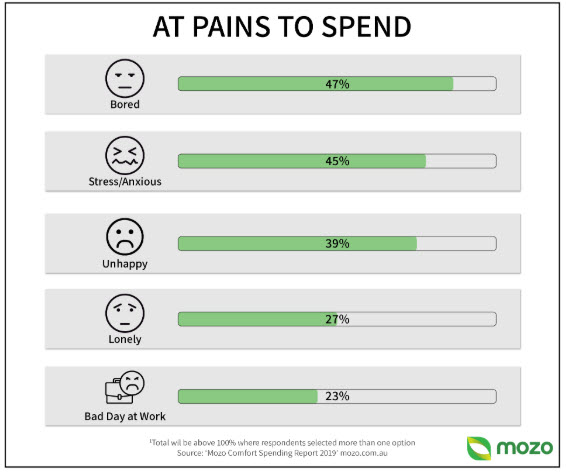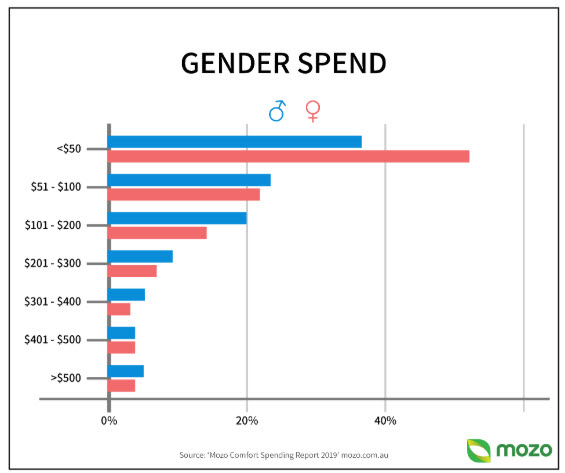How to avoid the traps of emotional over-spending
We all have bad days, that’s just life. And whether it’s picking up a tub of your favourite ice-cream, or indulging in a little retail therapy, we all have our go-to pick-me-up’s, to help get us through. No harm in that, right?
Well, according to Mozo’s recent Comfort Spending Report, Aussies are spending a whopping $25.5 billion a year to cope with stress, anxiety and boredom. Do the math, and this equates to $1,430 per person each year on average, which is particularly worrisome.
But, we get it. You overslept, your train’s delayed, you’re late to work, and to top it all off, you stub your toe, and now you’re a blubbering mess. We’ve all been there. But, before you jump online and do some damage with your credit card, consider the consequences of emotionally-driven impulse spending, and then ask yourself whether the designer shoes are really worth it.
While comfort spending within your means every so often isn’t exactly a crime, winding up in debt over a bad day at work is a serious financial danger zone which could ultimately impact on other areas of your life.
And while there’s no specific comfort spender gender (we all do it!), our Mozo data revealed that women are in fact, the biggest culprits of dropping the most cash.
So, now that we’ve given you the wakeup call you needed, here are a few strategies to help you bust your comfort spending habit!
Resist the urge to splurge:
How many times have you caught yourself pacing back and forth between the fridge and the pantry, only to realise that you’re not hungry at all, you’re really just looking to feed your boredom? Well, people don’t just eat when they’re bored, they online shop too!
So, if you’re in the 47% of Aussies who aimlessly shop when bored, then if you can’t resist the temptation, remove yourself from the situation! Unsubscribe from those spammy online clothing store E-newsletters and sale alerts that are clogging up your inbox, and while you’re at it, just go ahead and delete any shopping apps from your smartphone altogether. Out of sight, out of mind!
Don’t sweat it. Sweat it out!
Why pay off that new laptop for the next 12 months which you impulsively bought in anger because Jenny from the office keeps pinching your milk. With 23% of Aussies admitting to comfort spending after a bad day at work, we say a better way to blow off steam is by sweating it out instead!
Forget the expensive gym membership, just go for a jog, or kick a ball around. Nowadays you can find tonnes of free Zumba, pilates, yoga and other free easy to follow workout videos online. Whatever your schtick, just go for it!
Don’t mistake retail therapy for ACTUAL therapy
Take notice of any patterns in your comfort spending behaviour. If you find that yourself spending like crazy when you’re feeling anxious or right after a high-stress situation, then blowing your entire paycheck on overpriced makeup probably isn’t the answer.
Sure, your new purchase will make you feel better in the moment, but in the long run, you’d be far better off tackling the underlying issues that are causing the anxiety head-on. Take some time to reflect, by writing in a journal, or even talking to a close friend. If anything, over-spending will only give you more to stress about, especially if it means spiralling into credit card debt.
Set yourself a spending limit
If all else fails and you truly believe there’s no other alternative but to comfort spend, then at the very least set yourself a limit so that you only spend what you can afford and don’t sacrifice your savings or get yourself knee-deep in debt.
You might think that $100 for a new dress is nothing, but if you find you can’t pay it off the following month and end up paying it off over the next six months instead, then factor in the high credit card interest rate and that $100 dress could wind up costing you double!
Take control of your comfort spending habit before it controls you!
About the author:
As a personal finance writer at Mozo, Rhianna Dews arms Australian consumers with the insights and knowledge they need to make informed financial decisions. By turning complex finance topics and industry jargon into informative, easy to understand articles, Rhianna helps people become to take control of their personal finances and become more money-savvy.








No Comment